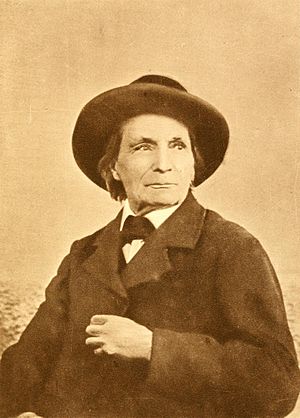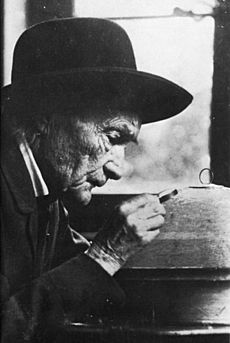Jean-Henri Fabre facts for kids
Quick facts for kids
Jean-Henri Fabre
|
|
|---|---|
 |
|
| Born | 21 December 1823 |
| Died | 11 October 1915 (aged 91) |
| Known for | Souvenirs Entomologiques (texts on insects and arachnids) |
| Scientific career | |
| Fields | Entomology |
| Influenced | Charles Darwin |
| Author abbrev. (zoology) | Fabre |
Jean-Henri Casimir Fabre (born December 21, 1823 – died October 11, 1915) was a French naturalist, an entomologist, and a writer. He was famous for his exciting books about the lives of insects.
Contents
Biography
Jean-Henri Fabre was born on December 22, 1823, in Saint-Léons, a small town in Aveyron, France. His family was not wealthy, so he mostly taught himself. Even so, he earned a teaching certificate at just 19 years old. He started teaching in Carpentras and continued his studies. In 1849, he got a teaching job in Ajaccio, Corsica. Later, in 1853, he moved to a high school in Avignon.

Fabre was a very popular teacher. He taught about physics, chemistry, and botany (the study of plants). However, he is best known for his work in entomology, which is the study of insects. Many people consider him the "father of modern entomology."
People loved his work because he was a great teacher and wrote about insects in a special way. He wrote about their lives like they were characters in a story, instead of just listing facts. He combined his "passion for scientific truth" with careful observations. He wrote in a friendly, easy-to-understand style. Fabre once wrote:
Some people have criticized my writing style. They say it's not serious or dry enough for science. They worry that if a page is easy to read, it might not be completely true. If I listened to them, we would only be considered smart if we were hard to understand.
His most famous work is Souvenirs Entomologiques. This is a series of books about insects and spiders. His writings even influenced Charles Darwin, a famous scientist, who called Fabre "an amazing observer."
Fabre was a Christian and was not fully convinced by Darwin's theory of evolution. He preferred to focus on careful, detailed observations in nature. He avoided making big conclusions too quickly.
In one of his most famous experiments, Fabre arranged pine processionary caterpillars in a circle around a pot. These caterpillars naturally follow each other's silk trails. The group kept moving in a circle for seven days! He also noticed that he could predict bad weather by watching how these caterpillars behaved.
Jean-Henri Fabre passed away on October 11, 1915. His work became well-known in English-speaking countries thanks to Alexander Teixeira de Mattos, who translated many of his books between 1912 and 1922.
Works
Fabre wrote many books, including textbooks for students and his famous works on insects. Here are some of his notable books:
- Souvenirs entomologiques (a series of 10 books about insects and spiders, published from 1879 to 1909)
- Chimie agricole (a textbook on agricultural chemistry) (1862)
- La Terre (The Earth) (1865)
- Le Ciel (The Sky) (1867)
- Fabre's Book of Insects (retold from his Souvenirs entomologiques)
- The Life of the Grasshopper (1917)
- Insect Adventures (1917)
- The Life of the Caterpillar (1919)
- The Life of The Scorpion (1923)
- The Glow-Worm and Other Beetles (1919)
- The Mason Bees (1925)
- The Life of the Spider (1912)
- The Life of the Fly (2001)
- The Hunting Wasps (2002)
- The Wonders of Instinct: Chapters in the Psychology of Insects (2002)
- Social Life in the Insect World
Legacy
Fabre's birthplace in St Léons, near Millau, is now a place called Micropolis. It's a fun place for tourists that teaches people about insects. It also has a museum about Fabre's life.
His last home and office, called the Harmas de Fabre in Provence, is also a museum. It shows his life and work. His amazing collection of insects is kept safe in the Musée Requien in Avignon.
In 1956, the French post office honored Fabre with a special stamp that showed his picture.
A movie about his life, called Monsieur Fabre, was made in 1951.
A fantasy novel from 2009, Blood of the Mantis by Adrian Tchaikovsky, is dedicated to Fabre.
Fabre also appears as a character in a short story called "The Famous Fabre Fly Caper" by Matthew Bennardo.
Images for kids
See also
 In Spanish: Jean-Henri Fabre para niños
In Spanish: Jean-Henri Fabre para niños


